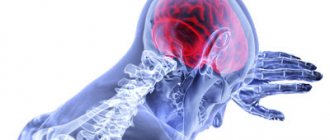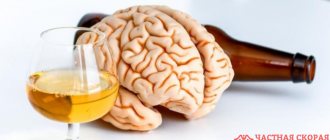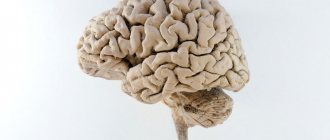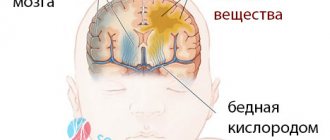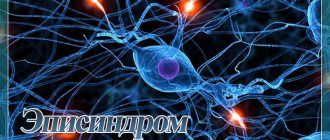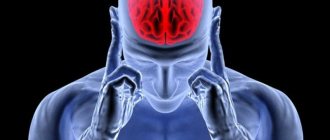© Author: A. Olesya Valerievna, candidate of medical sciences, practicing physician, teacher at a medical university, especially for SosudInfo.ru (about the authors)
Residual encephalopathy (residual - residual ) is a complex symptom complex, which is based on structural changes in the nervous tissue due to previous trauma, infection, ischemic damage, etc. It is a non-progressive neurological deficit of varying severity, which is usually not life-threatening.
The symptoms of residual encephalopathy can be very sparse, in other cases there is a clear neurological defect caused by necrosis of the brain substance. As active connections between neurons are restored during treatment, the patient’s condition may improve, or a persistent disruption of the central nervous system may develop, contributing to disability.
The most common accompaniments of “residual” encephalopathy are cranialgia, paresis, paroxysms of loss of consciousness, and autonomic dysfunction. Some patients experience decreased intelligence, constant fatigue, a tendency to depression, and emotional instability.
The older the patient, the more likely he is to exhibit residual encephalopathy. This diagnosis is also often made for babies, and the reasons may be birth injuries, intrauterine infection, obstetric care, etc. The conclusion about residual encephalopathy can come from previous perinatal encephalopathy, which was diagnosed immediately after birth or in the first weeks of life.
Due to the plasticity of a child’s brain, recovery processes in it occur much more intensively than in adults, so specialists are often faced with a situation where, after a significant period of hypoxia or serious damage, the baby’s brain recovers to an extent that does not require systematic and constant treatment.
Residual encephalopathy, as a rule, does not pose a threat to the life of its owner, but can still significantly worsen and limit it. In rare cases, it requires constant monitoring and treatment, and also interferes with work activity.
The term “residual encephalopathy” has been used for more than half a century, but such a diagnosis, as well as a separate nosological form, are absent in modern classifications. This is due to the need to clarify the causes of neurological disorders and prove their connection with a previous infection or other damaging agent.
In addition, if a neurologist suspects a “residual” nature of encephalopathy, he will need to find out whether the pathology is stable or progressing, so as not to miss other serious diseases that can hide for a long time under the guise of residual encephalopathy.
Careful observation of the patient and a detailed examination, according to some experts, leads to a change in diagnosis in almost half of the patients, which once again indicates the correctness of a scrupulous search for disorders in the brain, even if the diagnosis of residual encephalopathy seems the most “convenient” and simple.
Among the diseases that can “simulate” residual encephalopathy are some vascular anomalies, congenital metabolic diseases, slow-acting viral vasculitis (inflammation of the vascular walls) of the brain, and multiple sclerosis. To exclude them, a detailed medical history is obtained, the patient is carefully examined, CT, MRI, encephalography, laboratory tests of blood and urine, virological and cytogenetic tests are performed.
Due to the absence of residual encephalopathy in the classification of diseases as an independent pathology, certain difficulties with diagnosis often arise. The ICD-10 code is in sections coded G: G93.4 (unspecified encephalopathy), G 93.8 - other specified brain lesions, G 90.5 is used if residual phenomena are associated with a head injury. When formulating a diagnosis, it is important to indicate a specific harmful factor, clinical syndromes and their severity, and the degree of compensation for existing disorders.
What is residual encephalopathy? ICD-10 code
The term encephalopathy refers to damage to brain cells of non-inflammatory origin.
This process occurs due to disruption of microcirculation and oxygen starvation of the latter. This leads to the death of neurons with the formation of ischemic foci located diffusely in the cortex and subcortical formations. Residual encephalopathy in children is a “hodgepodge” of symptoms and syndromes that arise against the background of perinatal pathologies or diseases in the first year of a child’s life. Initial signs are usually nonspecific and appear in the first days after birth, but the formation of the final clinical picture, consisting of persistent residual effects, can last several years.
If the reliable cause of the disease is known, then the diagnosis may sound like this: “Residual period of hypoxic ischemic encephalopathy” and in this case the code P91.6 will be assigned. But more often in pediatric neurology situations arise in which the etiology of the disease is unknown. Then the code for the unspecified form of pathology is entered - G93.4.
Residual schizophrenia
Residual schizophrenia is also called residual schizophrenia. It is registered after exacerbations (attacks) and is characterized by stable remission without pronounced signs of psychosis. Although it can be asymptomatic, it is also impossible to say that a person is completely healthy in this condition.
The patient does not have hallucinations or delusions, but his behavior is very passive and uninitiative. The patient may say that everything is fine. However, relatives are usually concerned about his behavior and are very worried. They have cause for concern, since the disease can worsen at any time, despite the fact that sometimes a person remains in this state for years without any signs of psychosis.
Residual schizophrenia is rare - only 2.6% of patients.
Treatment is carried out not only during attacks, but also during remission. The further development of the pathology depends on its quality.
Reasons for the development of the condition
Residual encephalopathy of the brain has one global cause. And this is neuronal hypoxia, which is accompanied by the appearance of ischemic foci and edema. But there are many factors leading to this condition. They can act both in the prenatal period and after the birth of the child.
These include:
- severe pregnancy (eclampsia, threatened miscarriage);
- premature birth;
- infectious diseases suffered by the mother during pregnancy or by the baby up to one year;
- The woman is too young (under 18 years old);
- severe toxicosis, especially in the third trimester;
- consumption of alcohol, psychoactive substances, smoking;
- incompatibility of the blood of mother and child according to the Rh factor;
- birth injuries and umbilical cord entanglement;
- a prolonged period of pushing, leading to hypoxia or asphyxia of the fetus;
- action of ionizing radiation.
The presence of such complications and pathologies will not necessarily result in encephalopathy in the future. The child’s brain is extremely plastic; its healthy parts can take on the functions of the affected ones.
Causes
Nothing is known for sure about the causes of any schizophrenia. Scientists have not yet been able to describe the mechanism of development of the pathology. It has only been established that its focus is in the brain, but what exactly causes its occurrence and how it progresses remains a mystery.
Doctors have at their disposal a group of factors that can hypothetically provoke schizophrenia:
- Genetic predisposition. The likelihood of developing psychopathology increases if it has been identified in relatives. The closer the relationship, the higher the risk. A child with two schizophrenic parents has less than a 50% chance of avoiding the disease.
- Brain abnormalities. MRI shows that in schizophrenic disorders there is enlargement of the ventricles, atrophy of the hippocampus, temporal lobes and other areas.
- Problems that arise during pregnancy. We are talking about injuries, infections, unhealthy lifestyle of the mother, complicated childbirth and birth injuries.
- Social conditions. In families with alcoholics, drug addicts, psychopaths and other antisocial personalities, children may develop schizophrenia, psychopathy, schizoaffective disorder and other diseases. He definitely cannot avoid psychological trauma.
- Upbringing. As a rule, schizophrenics appear in families with oppressive parents or, on the contrary, in permissive conditions. Also, the likelihood of developing psychopathologies increases if no one cares for the child at all and no one loves him.
- Dependencies. Alcohol, drug addiction and smoking are not the direct culprits of schizophrenia, but they can serve as an impetus for its development. If a person began using psychoactive substances in childhood, the risks increase markedly.
Also, trauma, acute or chronic stress, prolonged depression, etc. can lead to schizophrenia or its exacerbation. The patient's medical history is studied carefully, but it is not always possible to draw a direct connection between one or another event and an attack of psychopathology.
Classification of residual encephalopathy
The classification of residual encephalopathy is based on the period of development of the child during which the damage to the nervous system occurred. There is a perinatal (congenital) form, which occurs from the 28th week of pregnancy until the end of the seventh day from the moment the baby is born, and an acquired form, which appears later. The first is a consequence of intrauterine development disorders and difficult childbirth, and the second is the result of the influence of infectious agents, toxins, and injuries.
In most cases, it is not possible to distinguish between these conditions, since signs of the disease can be detected several months after exposure to the causative factor.
Symptoms of the condition in children
Residual encephalopathy in children has many manifestations. The most common of them are:
- violations of the intellectual-mnestic sphere, expressed in mental retardation, poor performance at school;
- hydrocephalus external or internal;
- motor disorders in the form of paresis and paralysis;
- convulsive syndrome.
The presence of certain signs depends on the degree of damage to the brain substance and the location of the main foci of ischemia in it. At the initial visit to the doctor, only one of the syndromes may be observed, but in the absence of adequate therapy, residual encephalopathy tends to progress and over time, existing symptoms will worsen and new ones will appear.
How not to miss alarming symptoms?
The first “bells” of the disease in infants are extremely difficult to identify; a weak or delayed cry after birth, suppression of the sucking and grasping reflexes, and hemodynamic disturbances: heart rate and blood pressure should be alarming. Later the following symptoms are observed:
- irritability, tearfulness;
- sleep disorders - the child either sleeps around the clock or wakes up every half hour;
- hypertrophied reaction to a sharp sound, turning on the light;
- periodic shaking of the whole body;
- frequent persistent regurgitation or hiccups after feeding;
- throwing the head back;
- eye rolling;
- convulsions;
- increased or decreased muscle tone in the limbs.
If the pathology was not assessed in time, then encephalopathy can be suspected in older children:
- delayed psychomotor development;
- appetite disorders;
- dyssomnia (sleep disorders);
- frequent headaches and dizziness;
- mental disorders (apathy, tendency to depression, aggressiveness, decreased criticism);
- an increase in the size of the skull due to hydrocephalus.
Tips for parents
The only thing that can be advised to parents in view of such a disease as residual encephalopathy is to be more attentive to their children. When the first signs of pathology appear, you must immediately contact a specialist, since the sooner therapy is started, the greater the chance of reducing the effect of hypoxia on neurons.
Also, falls of children and infections cannot be ignored - they can cause the death of brain cells, and therefore require timely diagnosis and adequate treatment. The health of children is priceless; it is better to contact the pediatrician once again with a question of interest than to later try to cope with a neglected process.
Symptoms
Any form of schizophrenic disorder has two sets of symptoms - positive and negative. The first are called so not because they are “good”, but because they are a consequence of the activity of the psyche. Typical signs of productive symptoms are hallucinations and delusions.
In such a state of psychosis, the patient may be inadequate. Moreover, in most cases, he does not realize that he is sick, even if he sees grandiose and fantastic hallucinations.
The nature of hallucinations is individual. Some hear voices, while other patients see or touch objects that do not exist in reality.
With residual schizophrenia, there are usually no such symptoms. The patient is in a negative phase, which is revealed when the mental apparatus is passive. The main manifestations of residual schizophrenic disorder are:
- No signs of psychosis for 1 year or more. This period is considered as remission.
- Decreased motivation. A person does not want anything and does not strive for anything. He is not even interested in those activities that previously brought him pleasure.
- Emotionality. The patient may not respond to others and circumstances, including dramatic and difficult situations.
- Fatigue, weakness, both physical and moral, loss of strength. As soon as the patient takes up something, he immediately gets tired. Performance is practically zero.
- Closedness. With residual schizophrenia, a person does not want to communicate with anyone, he strives for loneliness, his speech is empty and meaningless. Often he tries not to speak at all.
- Poor hygiene. Over time, the patient stops taking care of himself - washing, shaving and washing clothes. Outwardly, he looks unkempt, but he doesn’t care.
- Strange behavior. The patient may talk loudly to himself in the presence of others, wander, collect garbage and bring it home (pathological hoarding).
- Superstitions. Belief in both the supernatural and complete absurdities, superideas, telepathy, etc. is possible.
To make a diagnosis of residual schizophrenia, four of the following symptoms must be observed. In this case, it is necessary to avoid organic brain damage, dementia and chronic depression, which are also characterized by negative symptoms.
Delusions, illusions, catatonia and hallucinations can occur in residual schizophrenia, but they are mild and do not cause vivid emotional experiences.
A person can be in remission for more than a year, but an exacerbation is possible at any time.
Then positive symptoms will appear, and probably even more intensely than during the previous attack. But this depends on how well the patient follows the doctor’s recommendations, as well as on the timeliness of therapy if the condition worsens.
Possible complications
With delayed diagnosis and lack of adequate treatment for the disease, encephalopathy progresses and is accompanied by the appearance of persistent organic brain damage.
As a result, such manifestations of the residual period may develop as:
- symptomatic epilepsy with secondary generalized seizures;
- early onset of Parkinson's disease (tremor, walking impairment);
- cerebral palsy (lack of movement in the limbs, muscle spasticity);
- vegetative-vascular dystonia (fluctuations in blood pressure, pulse);
- oligophrenia (impaired cognitive functions of the brain).
Residual encephalopathy often occurs with impaired speech formation, which leads to difficulties in the child’s socialization processes and entails serious psychological problems.
Diagnostics
The diagnosis is made by a neurologist. It is often associated with significant difficulties due to the significant period between the causative disease and the time of manifestation of residual encephalopathy. A thorough collection of anamnesis and complaints, a comprehensive laboratory and instrumental examination are necessary. The list of hardware techniques includes EEG, MRI and CT of the brain. According to indications, a spinal puncture is performed, and genetic tests are performed to exclude hereditary provoking pathologies.
Prognosis for a child's life
Residual encephalopathy in children is rarely fatal. The prognosis depends entirely on the degree of damage to the brain substance, the age of the child, early diagnosis and treatment. In severe cases, the pathological process involves up to 85-90% of neurons, which promises the patient profound disability.
If the provoking factor was detected and eliminated in time, and restorative therapy was started, then, given the plasticity of the child’s brain, one can hope for a full or partial recovery.
Diagnostic measures
Diagnosis of residual encephalopathy is aimed at identifying its causes and confirming diffuse damage to the brain substance.
For this use:
- physical examination to clarify the neurological status;
- laboratory tests (clinical blood and urine analysis, biochemical blood test, blood sugar test, thyroid hormones);
- EEG to identify epileptogenic foci;
- neurosonography in children under one year of age, since their large fontanel is not yet closed;
- Echo-ES is also an ultrasound method that can help identify signs of hydrocephalus;
- Doppler ultrasound, duplex or triplex scanning of the vessels of the head and neck - to clarify pathology and abnormalities in the development of the circulatory system that can lead to brain hypoxia;
- CT or MRI - these neuroimaging technologies make it possible to detect foci of ischemia, changes in the ventricles and subarachnoid space, and clarify the cause of the observed clinical picture.
The list of diagnostic measures is compiled only by the attending physician after a detailed examination. This will help in some cases to avoid a tomography, since young children will have to be under anesthesia to perform the procedure.
Diagnosis and treatment
Diagnosis for schizophrenia, like treatment, is not interrupted even during remission. The patient must periodically visit a psychiatrist and undergo certain tests. Thanks to this, you can notice signs of exacerbation at the initial stage. The same applies to therapy. In fact, after a diagnosis of schizophrenia is made, a person becomes a patient for the rest of his life, regardless of how often attacks occur or whether they occur in principle.
Treatment methods for exacerbation and remission are somewhat different. For residual schizophrenia, the following medications and techniques are used:
- Taking antipsychotic drugs. Their task is to restore dopamine activity, which malfunctions in schizophrenic diseases. With negative symptoms, the production of dopamine is insufficient, which is why the person is passive.
- Taking antidepressants. With their help, it is possible to activate the psyche by stimulating the production of serotonin.
- Hospitalization. In remission, the patient usually remains at home. He might even get a job. But sometimes doctors advise temporarily going to the hospital and undergoing additional examination, especially if there is a risk of an exacerbation.
- Psychotherapeutic sessions. They are individual and group. They are considered one of the most effective methods of treating schizophrenia during remission. The patient can talk to the doctor and also listen to other patients with similar diseases. This helps improve your mood and increase motivation.
- Working with loved ones. Relatives of a schizophrenic person consult a psychiatrist about the rules of communication with their loved one who is in the grip of schizophrenia. They must learn to communicate with him and quickly identify the symptoms of an attack.
- Education. In some cases, the patient is taught vocational skills so that he or she can work. Locking yourself in is much more dangerous. It is much more productive for the patient to work. In this case, monotonous and manual labor is preferable.
In general, treatment for residual schizophrenia is aimed at the patient’s social adaptation and reducing the negative impact of the pathology on the psyche.
Treatment approaches
Treatment of residual encephalopathy is always comprehensive and is aimed not only at correcting existing symptoms, but also at restoring damaged nerve tissue, protecting functioning neurons from hypoxia and other adverse factors. Treatment methods are always selected individually, taking into account the reasons that caused diffuse brain pathology, the age of the child and the observed clinical picture.
Most often, all manipulations can be performed on an outpatient basis with periodic visits to the doctor. In severe cases of the disease or its steady progression, a hospital stay may be necessary.
Basic treatment methods
The following methods are used in the treatment of residual phenomena of encephalopathy:
- physical therapy;
- physiotherapy (magnetic therapy, electrophoresis, DDT, paraffin therapy, mud therapy);
- reflexology (acupuncture);
- manual therapy and massages;
- diets with limited salt intake;
- occupational therapy and speech therapy for older children;
- exposure to medications;
- neurosurgical interventions (for example, shunting for hydrocephalus).
The positive effect of the carried out set of measures can be noticeable only after several courses of treatment. In some cases, the child has to resort to the help of specialists for many years. After recovery or when the progression of the pathology stops, children are registered at a dispensary.
Medications
Drug therapy prescribed for residual encephalopathy is designed to improve cell nutrition, facilitate oxygen access and restore the affected areas of the brain. For this use:
- vascular drugs (Cytoflavin, Trental, Nicotinic acid) - normalize microcirculation;
- neurometabolites (Cerebrolysin, Cerebrolysate, Cortexin) – contain a complex of amino acids necessary for neurons;
- neuroprotectors (Cerakson, Pantogam, Gliatilin) – protect against hypoxia, restore cell membranes, improve impulse transmission;
- antioxidants (Mexiprim, Mexipridol, Mexicor) – suppress lipid peroxidation and the action of free radicals;
- B vitamins (Milgamma, Neurovitan) – are the “building blocks” of the nervous system;
- anticonvulsants (Carbamazepine, Topiromat, Valprocom) – necessary for the development of symptomatic epilepsy;
- diuretics (Diacarb, Veroshpiron) - reduce increased intracranial pressure against the background of hydrocephalus.
The use of nootropics (Piracetam, Lucetam, Picamilon, Nootropil) is possible only in the absence of convulsive syndrome.
Treatment
Therapeutic measures must be comprehensive. Drug therapy is complemented by lifestyle correction. It is necessary to normalize the daily routine, alternating work and rest, sufficient time in the fresh air, and moderate physical activity. Physiotherapy and sanatorium-resort treatment are recommended, and sometimes psychotherapy is indicated. Medicines are prescribed taking into account the existing symptoms:
- cephalalgia: analgesics and NSAIDs;
- migraine: medications from the triptan group;
- dizziness: betaserc;
- insomnia, psychoemotional disorders: adaptogens, sleeping pills, antidepressants;
- intracranial hypertension: diuretics.
How to treat RE is determined individually. Patients are prescribed nootropics and nerometabolites. Children, along with symptomatic therapy, are given classes with a psychologist and a defectologist. The most important role is played by the participation of parents who support the baby and regularly work with him.
The forecast for the future is quite favorable. In most cases, with adequate complex therapy, it is possible to achieve the disappearance or significant reduction of symptoms. Patients lead normal lives: they study various professions, work, and build families. In severe cases, residual effects may persist, mainly headaches and autonomic disorders.
To make an appointment, just call tel. 8(969)060-93-93.
Prevention
Prevention of the development of residual encephalopathy in children consists of:
- regular visits to specialists during pregnancy to identify early signs of pathology, as well as indications for emergency or planned delivery;
- immediate treatment and prevention of various injuries and infections (bacterial, viral, fungal) in a child;
- maintaining a daily routine and physical activity appropriate to the baby’s age;
- proper balanced nutrition;
- the mother’s refusal of bad habits (smoking, drinking alcohol) during pregnancy and feeding.
